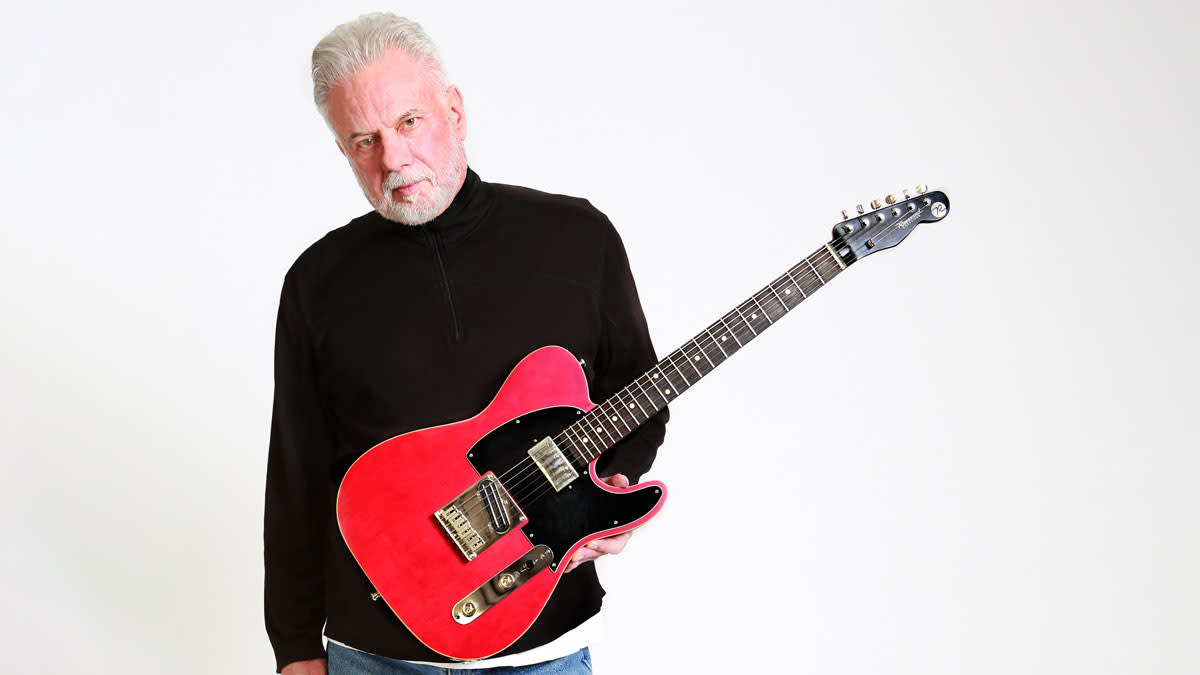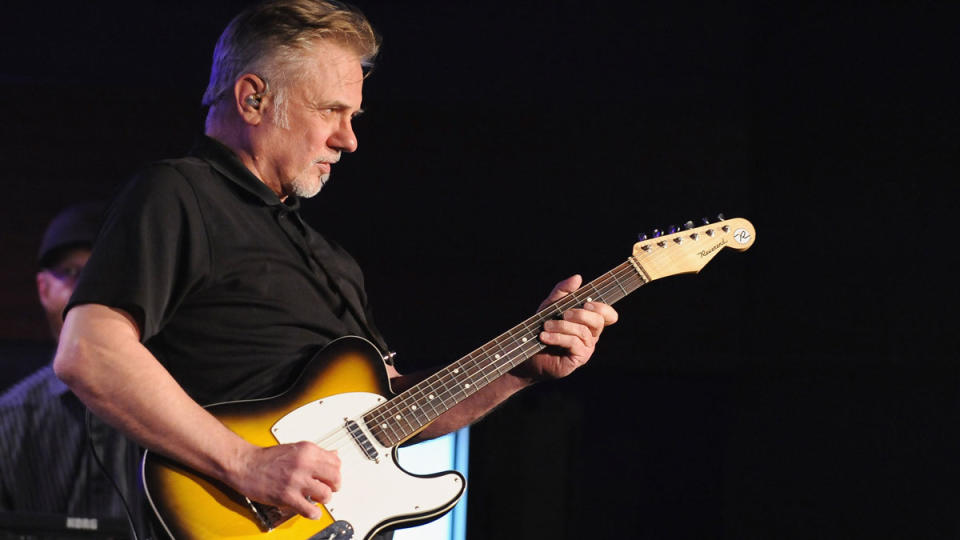“I kept trying to make it sound like a Gibson. That didn’t work. You have to give in to the Telecaster – it’s not for the faint of heart”: Dwight Yoakam’s former right-hand man Pete Anderson shares his tone and session guitar wisdom

Pete Anderson grew up in Detroit, Michigan, where he discovered music and guitar at an early age. He developed a passion for blues and country music, which served him well when he moved to Los Angeles and met Dwight Yoakam. The two worked together for close to 20 years, releasing a classic body of work that sold over 25 million records. It also put Anderson in the producer’s chair and established another facet of his career.
Earlier this year, Anderson published his first book, HOW TO PRODUCE A RECORD: A Player's Philosophy For Making A Great Recording. Much more than a how-to, the book offers a detailed glimpse into the psychology and techniques of session work and production. Anderson shares perspective, experiences, tips, and a lifetime of knowledge, and does so in a way that speaks to musicians and audio professionals of every level. It’s also a great read for fans of his work, and of music in general, who want some insight into the process.
Anderson is also a longtime Reverend Guitars artist. The relationship began when he approached the company at the 2006 Winter NAMM Show. He’d seen a guitar magazine ad featuring Kid Rock holding a Reverend and flashing what is, he says, “quietly known as the Motor City Salute”.
He engaged in a lengthy conversation with Reverend founder Joe Naylor, only to learn that their history began in a shop four blocks from Anderson’s childhood home. A kinship was born, and a signature line began with the Gretsch-inspired PA-1, followed by the Tele-esque Eastsider.
Of those designs, Anderson remarked, “What I wanted to accomplish was that if you were in a music store, saw the guitar, and liked how it looked, you would pick it up and play it, and before you ever plugged it in you would go, ‘Wow, I could really play this guitar, and if I put my strings on it, I could use it at my gig tonight.’” At this year’s NAMM Show, Reverend and Anderson debuted his fifth signature model, the Eastsider Custom.
What first drew you to the Telecaster?
If you're playing a Telecaster through a black-panel Twin, you better be able to play, or you must have a strong constitution as you listen to yourself play, because the reflection of what you're doing is so immediate
“My main impetus for playing guitar was seeing Elvis Presley when I was a kid. The attraction was the sound of the guitar, but at eight years old I thought Elvis was playing, when it was Scotty Moore. So my first attraction to guitars was more likely a Gibson, which is more forgiving. It's warmer.
“I was really inspired by B.B. King in my teen years, but Roy Buchanan hit the neighborhood and that wasn’t normal Tele playing. It was a mystery, like Hendrix with the Stratocaster. You're like, ‘Is that a guitar? What is that sound?’
“The fact that I was really attracted to blues, and Buchanan was definitely playing on the blues side of the page, made me curious. I had a good Gibson and I needed another guitar, so I said, ‘I’ve got to get a Telecaster.’ I started becoming more conscious of people that played the classic Telecaster sound, and it struck a chord with me. Switching from blues to country, the linchpin was James Burton, because Burton played very bluesy, but he also had played a lot of country.
“When I got into the Telecaster, I kept trying to make it sound like a Gibson. That didn’t work. You have to give in to the Telecaster. You have to give in to the treble and the sound. You have to tighten up your hands. With blues, you can slur and do different things that are more acceptable, but in country music it's more articulated.
“It's definitely an acquired taste. It's not for the faint of heart. And it's a great way to learn when you're starting out, because you can't hide. Nothing hides from the Telecaster. If you're playing a Telecaster through a black-panel Twin, you better be able to play, or you must have a strong constitution as you listen to yourself play, because the reflection of what you're doing is so immediate.
“Once you buy into the Tele, there's nowhere else to go. You don't go, ‘Well, I think I'll pick up a Strat.’ You hit that lead pickup and it just is not there. It's like, ‘Strat? Nope, not there. Gibson? Not there. Tele? Oh, I'm home.’”

In your book, you mention the Fender black-panel Deluxe and black-panel Twin as your preferences for overdubbing guitars. Are those your preferred amps all around?
“Yes, both of those. The Twin weighs, like, 120 pounds. It's huge. So in a perfect world, if you had somebody to carry it around and you could just switch back and forth between the two, yes.
Now we have digital sampling amplifiers that are unbelievable, so every song I've ever done pretty much has either been through a Twin or a Deluxe or a simulation of those amps
“Now we have digital sampling amplifiers that are unbelievable, so every song I've ever done pretty much has either been through a Twin or a Deluxe or a simulation of those amps. Occasionally, if it's really ratty, bluesy, slide guitar, I'll use a Silvertone. That's it. Those are my go-to amplifiers, but they're in the digital realm.”
While no one wants to be the “Get off my lawn” guy, shaking their fist at the sky, purists will be purists. To which you say…
“If it's founded, I'm all for it. What's better than a worn-out pair of denim jeans? They're comfortable, and you put in the work to make them feel that way. If there's a synthetic, pretend, worn-out fabric jean, I don't know that it’s going to make the cut. But when you take in the fact that I do blindfold tests – I'm not Mr. Technology, but if I can't pick out the software version or the digital reproduction version from the actual organic amplifier…
“Nobody wants to see me bending over after every song, adjusting my amp. If I have it set, I can play through a Twin and not be too loud, not have it weigh 120 pounds, and I can change different parameters of that guitar on every song by just pushing a button and programming it, I'd be stupid not to do that. It would be ridiculous. I use a Fractal. It’s amazing. I mean, we don’t read by candlelight anymore!”
What should guitarists consider when going into recording sessions?
“There's a small list of etiquette that you have to take into consideration if you're going to play sessions. It's like a puzzle. The quicker you solve the puzzle, the happier everybody in the room will be, the more they’ll like you, and the more they're going to want you to play on their stuff.
“I look at it like painting. If you’ve got four artists painting on the canvas together, you have to find a place where your color fits in and complements the other three people.
“The guitar player should listen to the hi-hat, stay out of the way of the left hand of the piano, and stay in the midrange. When the artist goes up, you go down. When the artist goes down, you go up. Those are some simple rules for fitting in. You don't have to do much. They’re not paying for virtuosos, or for guys that come in with their pedalboards and people are setting up and you're riffing away and you're annoying as hell and you play things that are aren't appropriate.
“Session musicians have to become a really good band for every song, really quick. You have to find your spot immediately, bury your nose in the chart, get the gist of it as quickly as possible, and build your part. That part should be something that repeats every verse, and a different part that repeats every chorus. You do that, you're going to be in pretty good shape.
“Make sure your amp doesn't buzz and make a bunch of noises, that it's in good shape, and that your guitar is intonated, because you can tune it, but if it's not intonated, you're going to be out of tune all day. Have a couple instruments that you might need. If you're really going to do this, you need an acoustic guitar, a Fender, and probably a Gibson.”
The years with Dwight Yoakam were a learning experience for you. Something that stands out, even more so in this era of television competitions and TikTok fame, is the tenacity. You said, “One place we auditioned for wouldn't give us a gig. They said we were too country. A year later, bands were covering the songs that got us fired.”
“There are reasons for it. It was like a big brother/little brother relationship. Dwight was born in Kentucky, but he was raised in Columbus, Ohio. I was raised in Detroit. Your environment does set some values, so we had similar backgrounds, although I was nine years ahead. That was one thing.
“I think we were personally a little bit more tenacious in our approach than the normal person that comes to California looking for fame and fortune. We were also extremely aware of the legacy of country music.
“I've said in interviews that we both loved honky-tonk traditional country music, but Dwight was much deeper in bluegrass and I was much deeper in blues. You put those together and you've got rockabilly honky-tonk country. That’s what we did, and that made it unique.
“And we had a relationship where I was really allowed to affect the music, which created the association of Dwight's voice and the sound of my guitar, so that became a tool that we could use. I think all those factors really fueled it.”
HOW TO PRODUCE A RECORD: A Player's Philosophy For Making A Great Recording is out now and available via Amazon.
